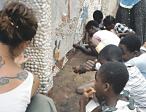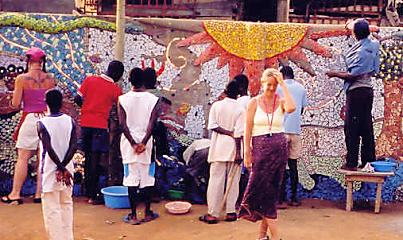MOSAIC MURAL WORKSHOP, August 2001, facilitated by Laurel True
Laurel True, a San Francisco artist, and the children of Nungua, Ghana conceived and constructed a mural at ABA HOUSE in Nungua. Step one was to visit the linguist (spokesman) of the Nungua chief. He related the oral history of the Ga people... how they migrated from the North stopping to hunt, plant crops and eventually settle in Nungua. They chose Nungua because it is a beautiful village next to the ocean where the abundant fish supply provided a livelihood for the Ga people. Laurel and the children translated the story into a permanent visual record using mosaic tile and working on a cement wall that encloses the workshop used by CCC, Inc. The project was so successful and generated so much interest that Laurel will return to continue working with the children.
OGBE BE (GOOD HARVEST)
THE HISORY OF NUNGUA MOSAIC MURAL – 2001 NUNGUA, GHANA
By Laurel True and the people of Nungua in partnership with Cross Cultural Collaborative, Inc.
I had been to Ghana once before as a 20 yr. old student and had traveled in other parts of Africa, but never felt the connection with a place more than in Ghana.
After an interest in textiles, my passion shifted to tile, glass and mixed media mosaic. I have a 12 year history making mosaics, working on public art, architectural mosaic applications and community mosaic projects. I have traveled widely gaining inspiration from the decorative arts of many countries and my dream was to return to Ghana and do a mosaic project there.
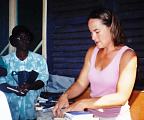 One day I was flipping through a magazine and came across an article about a woman who conducts crafts tours to Ghana and specializes in creating personalized programs for artists who want to explore certain aspects of Ghanaian art. I went online to learn more about Ellie
(Aba) Schimelman and Aba Tours. Aba and I communicated by e-mail and phone and I submitted a proposal to do a community mosaic mural project with Ghanaian school children. My proposal coincided with the creation of Cross Cultural Collaborative,
Inc., a non-profit which brings together Ghanaian and outside artists to do collaborative projects.
Aba, an artist with a long connection to Ghana, had spent the last four years funding the construction of a community arts center and guest house in Ghana to provide the local community with an arts based cultural center.
One day I was flipping through a magazine and came across an article about a woman who conducts crafts tours to Ghana and specializes in creating personalized programs for artists who want to explore certain aspects of Ghanaian art. I went online to learn more about Ellie
(Aba) Schimelman and Aba Tours. Aba and I communicated by e-mail and phone and I submitted a proposal to do a community mosaic mural project with Ghanaian school children. My proposal coincided with the creation of Cross Cultural Collaborative,
Inc., a non-profit which brings together Ghanaian and outside artists to do collaborative projects.
Aba, an artist with a long connection to Ghana, had spent the last four years funding the construction of a community arts center and guest house in Ghana to provide the local community with an arts based cultural center.
I became the first American participant in the CCC, Inc. program by designing and facilitating a mosaic mural project to be sited on the inner wall of the cultural center. Aba works closely with her Ghanaian counterpart, Ben Adipah who is employed by the Ministry of Education. Ben acted as a consultant throughout the project and arranged for school children to participate.
We agreed that I would spend a month in Ghana working with the children on a mosaic depicting the visual history of the village where Aba House is located. Ben arranged for us to visit the chief and local elders to hear the oral history of the area. Aba arranged my plane fare, accommodations, etc. We had never met, but I had a note on the back of my itinerary about where to look for her when I came out of the airport in Accra.
Aba had left word with Talk True, the Aba House manager, to save broken and discarded tiles. I had no idea what materials would be available so I kept an open mind. As Nungua is a fishing village, I knew that there would be plenty of pebbles and shells available, so I was prepared for a mixed media mural. I planned to pack some glazed tile in my luggage so as to be sure to have certain colors to use.
My assistants and I carefully chose, weighed and packed two 70lbs. boxes of ceramic tile. I used tile from Heath Ceramics, a California manufacturer who produces rich and durable colors. I paid for my own suitcases as extra luggage and was on a flight to Ghana.
I was met at the airport by Aba and her driver, Chuku. We drove the half hour to Nungua in excitement. I was so glad to be back in Ghana. Aba House is a gorgeous, two story house with traditional red earth plastered walls and thatched roof. Aba has remained true to the traditional building methods of Ghana.
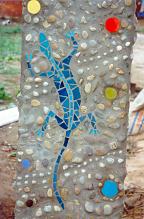 The first day I met Talk True who would become my guide, friend and artistic counterpart. He is a master resourcer and self proclaimed “Economics Man”
- able to organize finances and find the best deals everywhere. Talk True and Aba showed me the concrete wall where the mosaic was to be sited. Then I was able to project the size of the mural by estimating how much space
could be covered in the time I would be there. The wall had been built with sectional breaks that made natural dividers. I designated two 10 ft. long sections for the mural that would be 6 ft. tall. Total mural
footage would be 150 sq. ft. including borders.
The first day I met Talk True who would become my guide, friend and artistic counterpart. He is a master resourcer and self proclaimed “Economics Man”
- able to organize finances and find the best deals everywhere. Talk True and Aba showed me the concrete wall where the mosaic was to be sited. Then I was able to project the size of the mural by estimating how much space
could be covered in the time I would be there. The wall had been built with sectional breaks that made natural dividers. I designated two 10 ft. long sections for the mural that would be 6 ft. tall. Total mural
footage would be 150 sq. ft. including borders.
That first day I met Ben. He and Aba have a special and close professional bond which is evident and put me at ease. They are a great team and I felt secure with their support. A third counterpart, Sammy, was mentioned often in the planning of the culture center. I was to meet him later.
Aba provided me with a beautiful room with rich, red earth walls, a soft bed, a cool ocean breeze and my own bathroom. I was to experience Aba as a warm, generous woman with the patience and understanding of a saint. Her vision of the cultural center was inspiring and her dedication to the arts in Ghana was deep. As an artist herself, I found her priorities and sensibilities not only visionary, but creative and practical. I believe that Aba can and does anything she puts her mind to. She is charming, compassionate, resourceful and funny. Becoming friends with Aba was a fantastic bonus.
I began working on the mural my first day in Ghana. Aba and I discussed design direction and the idea of drawing from the Asafo Flag (an appliqué textile tradition from Central Ghana) as a design style.
We visited the Chief's Linguist and told him about our project. He and the village elders reviewed my portfolio. Although the use of mosaic tile for floor covering is widespread in Ghana, it is rare to see it on a wall. There were smiles and nods and comments made in the local language. The Linguist recounted the oral history of the Ga people and their arrival from Eastern Africa and Israel before they settled on the shores of what is now Nungua, becoming farmers and fishermen. I took notes and asked about crops, animals, fishing practices and other things that we would depict in the mural. When everyone was satisfied and the proper thanks given, we asked permission to leave. This visit gave me the raw materials to design the mural which would be titled “Ogbe Be”-Good Harvest. It was decided to use local children and residents rather than going through a formal school project. The mural gained community interest and the yard at Aba House started to buzz with anticipation.
Nungua is 30 minutes from the capital of Accra. Even though the village was settled by the Ga, there are people from all ethnic groups. I learned much about and from the many different people in Nungua. The greater Accra area is a melting pot of Ghanaian culture and languages.
I enjoyed the camaraderie of the trades people working at Aba House - the tile setters, cabinet makers and other specialists. It was fascinating to see the different approaches and tools. There was much curiosity about the Obruni (white, foreign lady) and her mosaic project since women in Ghana do not usually do trade work.
Coinciding with the design phase was the gathering of materials. Talk True and I carefully unwrapped the tile and sorted it by color. We also sorted all the broken tile and estimated what was still needed. Some of the children gathered stones and shells. After everything was sorted by size and color it was easier to see what was still needed.
Talk True and I took a tro-tro (local bus) to Makola Market in Accra. We dodged all manner of people and goods, animals and vehicles, finally arriving at the plumbing and tile section. Tile selections, mostly European imports, were displayed on tall boards. Ghanaians are masters of display and everything looked fabulous. We bought four bags of tile cement, three rice sacks full of broken tile and a stack of deep red whole tiles.
The original design was drawn to scale and transferred to the wall using a simple grid, tape measure and straight stick which substituted for the level that I forgot to bring. Colored chalk was used for color coding and design transfer.
In the tradition of Asafo flags, we designed a bold red, black and white triangle boarder. Depicted in the mural were men and women, the sun, birds, animals, fields of corn, coco yam in baskets, palm trees, a Sankofa bird, a path, islands, sea animals and fish, fisherman on the sea with their nets, a fish market, smoking oven and a woman making banku, clouds and more birds in the sky. The border was the first part of the mural that we worked on.
 People were very interested in the process, and were always available to help. I gave a lesson in mixing thin set and back buttering
tesserae for the direct application method. The Ghanaian team set the border, getting used to the process, while I started on the design element. I had brought flat head tile nippers, rotary mosaic nippers, tack hammer,
rubber gloves, leather palmed gloves, chalk, blue tape, tape measure and colored pencils. Everybody got a lesson in everything and we all took turns processing the tiles, mixing thin set and sharing tools.
People were very interested in the process, and were always available to help. I gave a lesson in mixing thin set and back buttering
tesserae for the direct application method. The Ghanaian team set the border, getting used to the process, while I started on the design element. I had brought flat head tile nippers, rotary mosaic nippers, tack hammer,
rubber gloves, leather palmed gloves, chalk, blue tape, tape measure and colored pencils. Everybody got a lesson in everything and we all took turns processing the tiles, mixing thin set and sharing tools.
The border was done in broken shapes of dark red tile, white beach shells and broken black tile. Design elements were set using broken and nipped shapes. We improvised an old cement block as a tile stone and I taught how to nip and curve specific shapes which added to the overall design and texture. The most predominant setting style was the contemporary broken tile. Sizes of tesserae ranged from ¼" to 2-3”.
As days passed new people arrived to participate - usually 5-10 people of different ages would work at different times during the day. Even Aba got down in the dirt! Some came only once, some came every day and some whenever they could. As we were all volunteering our time and energy, the driving force was to learn, share, have fun and create an interesting piece of art. Aba was very encouraging and she promoted the project to local artists and friends.
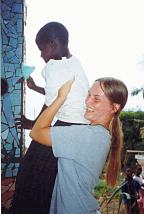 Two secondary school students, Elizabeth and Dora, came to work and learn about mosaics and became teachers to the younger participants.
The atmosphere - sometimes 10 hrs. a day - was upbeat and jovial. We joked, laughed and poked fun at each other. Talk True and Emmanuel kept us in stitches and there were definitely times when I wished I understood Twi.
Aba and Talk True and I would stay up at night talking and telling stories about American and Ghanaian customs.
Two secondary school students, Elizabeth and Dora, came to work and learn about mosaics and became teachers to the younger participants.
The atmosphere - sometimes 10 hrs. a day - was upbeat and jovial. We joked, laughed and poked fun at each other. Talk True and Emmanuel kept us in stitches and there were definitely times when I wished I understood Twi.
Aba and Talk True and I would stay up at night talking and telling stories about American and Ghanaian customs.
In order to get more children involved in the mosaic we designated one Friday as "kids day". Aba's friend Sammy brought his son from Hohoe which was a 5 hour trip. Salom, like his father, was already a talented artist and learned a lot in the week he spent with us at Aba House. Ben brought 3 of his nieces from Accra and beginning in the morning we had a stream of children arriving. They each got a name tag.
We organized the children into teams of two and gave each a specific line to follow. It was seamless. All of the kids were great listeners and very well behaved and proud of what they were doing. It was a great day with over 30 kids participating. Elizabeth, Dora, Vincent and I mixing cement, delegating and supervising. We got more done that day than any other day of the project. And the kids LOVED it. At the end of the day I handed out gifts of magic markers, postcards and thanks. We took a lot of photos and some of the parents came over to have their pictures taken with the kids.
 Mural production went smoothly after that. Two weeks into the project half of the mural was completed.
The addition of mirror to the water in the second half was exciting because with it the waves depicted seem to move and change in the light. As the participants became more experienced they took pride in completing special cuts.
I also gave a short workshop so they could practice setting letters in mosaic. Everyone did a plaque with their initials.
Mural production went smoothly after that. Two weeks into the project half of the mural was completed.
The addition of mirror to the water in the second half was exciting because with it the waves depicted seem to move and change in the light. As the participants became more experienced they took pride in completing special cuts.
I also gave a short workshop so they could practice setting letters in mosaic. Everyone did a plaque with their initials.
A dedicated team saw the project to its completion. The final phase was the grouting. Talk True arranged to have several bags of cement and a pile of sand delivered. We mixed 3 parts sand, one part cement with water on the ground using a shovel. After four weeks of long, sweaty days mixing thin set, breaking and setting tile, carrying buckets of water and materials, the guys wouldn’t let me mix cement. It was “man’s work”. That I loved.
I had packed a number of cellulose sponges for grouting, as well as two tile sponges. I had forgotten to pack grout floats. I was describing the tool to one of the tile setters working at Aba House and he said he had seen them, but just used chalawati…which are flip-flops! Several people traded in their flip flops for the cause (I replaced them with new ones). As there was a lot of textural changes, the sponges proved more useful. The process was swift, with groups working on grouting, washing and buffing. We used old toothbrushes to get grout off shells and stones. We grouted the whole mural in a few hours. We cleaned and buffed with old T shirts and my bath towel.
At last the mural was finished. People came from all over to view it with nods of approval and much discussion. I promised to return the following year to do another mosaic project and wondered if I’d come back to a transformed Nungua, bursting with mosaics done by all the new artists.
My final days in Ghana were happy and sad. It was easier to leave knowing that there was a lot more wall space left at Aba House.
 I had completed a great project, one that I had dreamed of doing, learned so much, gotten to travel a bit and had made so many friends.
My send off was spectacular with seven of us squeezing into one little car to take me to the airport.
Ben's 80 year old mother gave me a wonderful beaded bracelet and Ben and Aba conspired to have a basket and Kente cloth made especially for me.
In fact, I got double everything because I am a twin. In Ghana when you give to one twin, you must give to the other.
I had completed a great project, one that I had dreamed of doing, learned so much, gotten to travel a bit and had made so many friends.
My send off was spectacular with seven of us squeezing into one little car to take me to the airport.
Ben's 80 year old mother gave me a wonderful beaded bracelet and Ben and Aba conspired to have a basket and Kente cloth made especially for me.
In fact, I got double everything because I am a twin. In Ghana when you give to one twin, you must give to the other.
Part of my life is definitely in Ghana and I look forward to returning in 2002. Aba’s non-profit, Cross Cultural Collaborative, Inc. is gaining momentum and more artists are traveling to Ghana to do workshops and collaborations.
I give thanks to CCC, Inc., Ben, Sammy, Talk True and all my friends in Nungua for adding to the richness of my life. Ghana is a beautiful, loving country with so many talented artists and inspiring places.
Thank you especially to Aba. You are an inspiration and wonderful woman. Thank you for bringing me back to Ghana in the most perfect way.
Laurel True - True Mosaics San Francisco, CA USA


